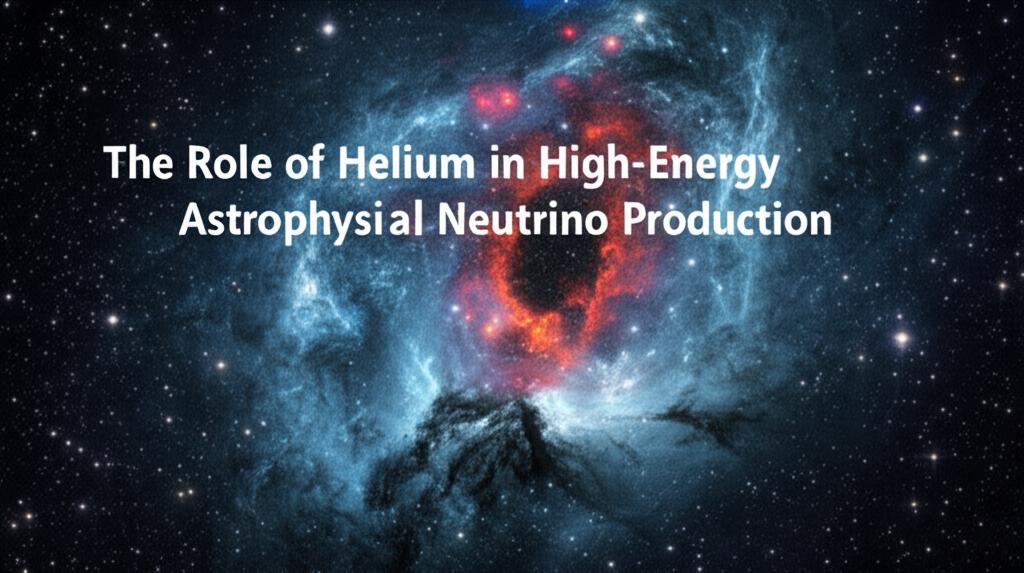High-energy astrophysical neutrinos, ghost-like particles that travel vast cosmic distances, offer a unique window into the most extreme environments in the universe. Recent research highlights the significant, and sometimes surprising, role that helium plays in the production of these elusive messengers.
One of the key ways helium contributes to neutrino production is through interactions with cosmic rays. Cosmic rays, which are high-energy particles (mostly protons and heavier atomic nuclei), can collide with interstellar gas and radiation fields. When helium nuclei, the second most abundant element in the cosmos after hydrogen, are part of this interstellar medium or are themselves accelerated as cosmic rays, these interactions can lead to the creation of pions. These pions subsequently decay into muons and neutrinos. The specific energy spectrum and flux of the resulting neutrinos are influenced by the abundance and energy of the helium involved.
A noteworthy recent finding concerns the galaxy NGC 1068, also known as the "Squid Galaxy." This galaxy emits a strong flux of high-energy neutrinos but, perplexingly, relatively weak gamma rays. This observation challenges traditional models where high-energy neutrinos and gamma rays are typically produced in tandem, often through proton-proton or proton-photon interactions. A new model proposes that the high-energy neutrinos from NGC 1068 primarily result from the decay of neutrons. These neutrons are released when helium nuclei, accelerated in the jets emanating from the galaxy's central supermassive black hole, collide with intense ultraviolet photons in the region and fragment. This process, called photodisintegration, explains the observed neutrino abundance without a corresponding strong gamma-ray signal because neutrons can decay into neutrinos without necessarily producing high-energy gamma rays. Hydrogen, by contrast, having only a proton, would produce both neutrinos and strong gamma rays in similar interactions. This discovery suggests the existence of previously hidden astrophysical neutrino sources that may have gone unnoticed due to their faint gamma-ray signatures.
The chemical composition of ultra-high-energy cosmic rays (UHECRs) is another area where helium's role is crucial. Cosmogenic neutrinos are produced when UHECRs interact with background photon fields like the cosmic microwave background (CMB) during their journey across the universe. If UHECRs are predominantly protons, a certain neutrino flux is expected. However, recent data suggest that the composition of UHECRs might be mixed, with a significant fraction of helium and even heavier nuclei. The presence of these heavier nuclei, including helium, can affect the expected cosmogenic neutrino flux, generally leading to a suppression of neutrino production compared to a purely protonic composition. Understanding the exact fraction of helium in UHECRs is therefore vital for accurately predicting and interpreting the observed cosmogenic neutrino spectrum.
Furthermore, helium plays a role in various stellar environments where neutrinos are produced. For instance, in the cores of stars, nuclear fusion processes, including those involving helium (like the CNO cycle or helium burning itself), produce neutrinos, though these are typically of lower energy than the high-energy astrophysical neutrinos detected by observatories like IceCube. However, in more extreme stellar events, such as core-collapse supernovae that produce jets, the interaction of these jets with the progenitor star's material (which can be rich in helium, especially for Wolf-Rayet stars that have shed their outer hydrogen envelopes) can also be a site for high-energy neutrino production. The photodisintegration of helium nuclei in intense photon fields within these environments can lead to neutron decay and subsequent neutrino emission.
In summary, helium is a key player in the complex processes that generate high-energy astrophysical neutrinos. Its abundance in the universe, its involvement in cosmic ray interactions, its role in the photodisintegration processes within active galactic nuclei and other extreme environments, and its presence in the composition of UHECRs all significantly influence the production and characteristics of the high-energy neutrino sky. Ongoing and future research, including data from experiments like IceCube and KM3NeT, will continue to refine our understanding of helium's precise contribution to this exciting field of astroparticle physics.

